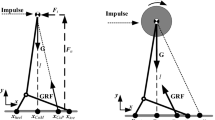Abstract
In this paper we discuss our simulation and empirical study of a golf swing motion controller for a two-link golf swing robot. We distinguish two variants of the whole golf swing termed as hitting problem and stopping problem. For the hitting problem arising from backswing and downswing, we map the task into the output of a target dynamic system—a harmonic oscillator—under energy control. For the stopping problem that arises from follow-through, we propose a Proportional plus Gravity and Coupling Torque Compensation (PGCTC) feedback controller. Preliminary simulation study shows the proposed controllers solve the hitting problem and the stopping problem respectively. The controllers are implemented on a physical robot. Experimental results indicate the robot is able to perform desired golf swing-backswing, downswing, and follow-through. We also give a preliminary analysis on the proposed method to understand its merits and weaknesses.
Similar content being viewed by others
Explore related subjects
Discover the latest articles, news and stories from top researchers in related subjects.References
Asada, H., Slotine, J.-J.E.: Robot Analysis and Control, p. 9. Wiley, New York (1986)
Vukobratovich, M., Kirchanskiy, N., Petrovich, T.: The design of high-speed robot regulators based on pipeline processors. Int. J. Comput. Syst. Sci. 31(6), 125–133 (1993)
Pierrot, F., Frasisse, P., Delebarre, X., Dauchez, P.: High-speed robotics-A completely parallel system. Rairo-Automatique-Productique Informatique Industrielle-Automatic Contr. Prod. Syst. 26(1), 3–14 (1992)
Andersson, R.L.: A Robot Ping-Pong Player: Experiment in Real-Time Intelligent Control. MIT Press, Cambridge (1988)
Ming, A., Kajitani, M.: Human skill and ultra high speed manipulator. In: Proceedings of the 3rd France-Japan Congress and 1st Europe-Asia congress on Mechatronics, pp. 436–441 (1996)
Ming, A., Kajitani, M.: Human dynamic skill in high speed actions and its realization by robot. J. Robot. Mechatronics 12(3), 318–334 (2000)
Suzuki, S., Inooka, H.: Golf swing robot emulating a human motion. In: Proc. IEEE Int. Workshop, Robot and Human Communication, pp. 28–33. IEEE (1997)
Suzuki, S., Inooka, H.: A new golf-swing robot model utilizing shaft elasticity. J. Sound Vib. 217(1), 17–31 (1998). doi:10.1006/jsvi.1998.1733
Suzuki, S., Inooka, H.: A new golf-swing robot model emulating golfer’s skill. Sports Eng. 2, 13–22 (1999). doi:10.1046/j.1460-2687.1999.00013.x
Suzuki, S., Haake, S.J., Heller, B.W.: Multiple modulation torque planning for a new golf-swing robot with a skilful wrist turn. Sports Eng. 9, 201–228 (2006)
Hoshino, Y., Kobayashi, Y., Yamada, G.: Vibration control using a state observer that considers disturbances of a golf swing robot. JSME Int. J. Ser. C. 48(1), 60–69 (2005). doi:10.1299/jsmec.48.60
Chen, C.C., Inoue, Y., Shibata, K.: Numerical study on the wrist action during the golf downswing. Sports Eng. 10, 23–31 (2007)
Chen, C.C., Inoue, Y., Shibata, K.: Impedance control for a golf swing robot to emulate different-arm-mass golfers. ASME J. Dyn. Syst. Meas. Control 130(2), 021007–021008 (2008)
Yamakita, M., Ueno, M., Sadahiro, T.: Trajectory tracking control by an adaptive iterative learning control with artificial neural networks. In: Proc.American Control Conf., pp. 1253–1255. AACC (American Automatic Control Council) (2001)
Zheng, X., Inamura, W., Shibata, K., Ito, K.: Robotic batting system-an architecture for learning and dynamic pattern generation. Adv. Robot. 14(5), 435–437 (2000). doi:10.1163/156855300741843
Senoo, T., Namiki, A., Ishikawa, M.: High-speed batting using a multi-joint manipulator. In: Proc. IEEE Int. Conf. Robotics and Automation, pp. 1191–1196. IEEE (2004)
Ming, A., Mita, T., Dhlamini, S., Kajitani, M.: Motion control skill in human hyper dynamic manipulation – An investigation on the golf swing by simulation-. In: Proc. IEEE int. Symposium on Computational Intelligence in Robotics and Automation, p. 4752. IEEE (2001)
De Luca, A., Oriolo, G.: Trajectory planning and control for planar robots with passive last joint. Int. J. Robot. Res. 21(5-6), 575–590 (2002). doi:10.1177/027836402321261940
Bobrow, J.E., Dubowsky, S., Gibson, J.S.: Time-optimal control of robotic manipulators along specified paths. Int. J. Robot. Res. 4(3), 3–17 (1985). doi:10.1177/027836498500400301
Shin, K.G., McKay, N.D.: Minimum-time control of robotic manipulators with geometric path constraints. IEEE Trans. Automat. Contr. 30, 531–541 (1985). doi:10.1109/TAC.1985.1104009
Pfeiffer, F., Johanni, R.: A concept for manipulator trajectory planning. IEEE Trans. Robot. Autom. 3, 115–123 (1987)
Slotine, J.-J.E., Yang, H.S.: Improving the efficiency of time-optimal path-following algorithms. IEEE Trans. Robot. Autom. 5, 118–124 (1989). doi:10.1109/70.88024
Shiller, Z., Lu, H.-H.: Computation of path constrained time optimal motions with dynamic singularities. ASME J. Dyn. Syst. Meas. Control 114, 34–40 (1992)
Nakanishi, J., Fukuda, T., Koditschek, D.E.: A brachiating robot controller. IEEE Trans. Robot. Autom. 16(2), 109–123 (2000). doi:10.1109/70.843166
Isidori, A.: Nonlinear Control Systems, 3rd edn. Springer, New York (1995)
Ishikawa, M., Neki, A., Imura, J., Hara, S.: Energy preserving control of a hopping robot based on hybrid port-controlled hamiltonian modeling. In: Proc. of SICE 2003 Annual Conference, vol. 3, pp. 2611–2616. SICE (The Society of Instrument and Control Engineers of Japan) (2003)
Astrom, K.J., Furuta, K.: Swing up a pendulum by energy control. Automatica 36(2), 287–295 (2000). doi:10.1016/S0005-1098(99)00140-5
Hardt, M., Kreutz-Delgado, K., Helton, J.W.: Minimal energy control of a biped robot with numerical methods and a recursive symbolic dynamical model. In: Proc. of IEEE Int. Conf. Decision and Control, pp. 413–416. IEEE (1998)
van der Schaft, A.: L2-Gain and Passivity Techniques in Nonlinear Control, p. 105. Springer, London (2000)
Author information
Authors and Affiliations
Corresponding author
Rights and permissions
About this article
Cite this article
Xu, C., Ming, A., Nagaoka, T. et al. Motion Control of a Golf Swing Robot. J Intell Robot Syst 56, 277–299 (2009). https://doi.org/10.1007/s10846-009-9312-3
Received:
Accepted:
Published:
Issue Date:
DOI: https://doi.org/10.1007/s10846-009-9312-3




